Integrating Conveyors and Industrial Lifts
Ways to use scissor lifts and vertical conveyors to enhance conveyor systems
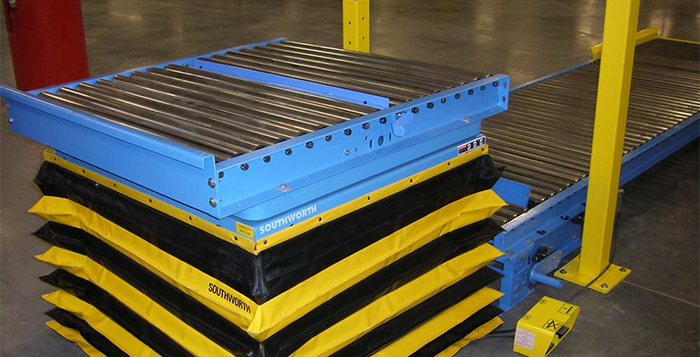
Above: scissor lift/rotator at the end of pallet conveyor line
Conveyors and scissor lifts are frequently integrated due to the fact that it’s such an efficient way to manipulate loads along a conveyor line. Loads can be lifted, raised or rotated on a lift table for a variety of activities. When you need to actively work on a conveyed item, it’s ideal. Here’s how to go about it.
Types of conveyor integrations
Lifts of all types can be integrated with conveyors. Scissor lifts tend to be used for load manipulation (left-right, rotate, up-down). Vertical conveyors are used for vertical pallet and package elevation and discharge.
In-line scissor lifts
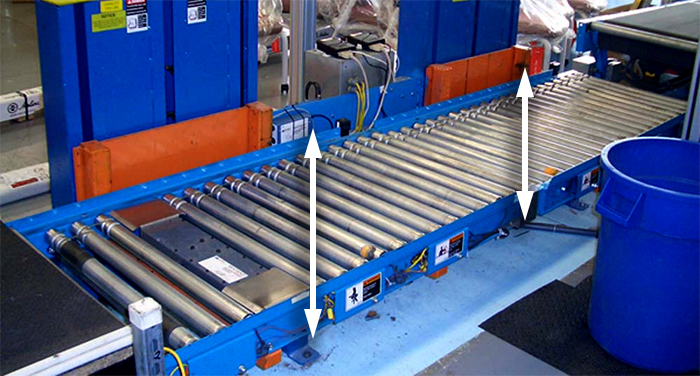
Above: this scissor lift can raise to match conveyor line height or lower to the floor for access to conveyed components from more ergonomic positions.
These applications integrate a scissor lift into a conveyor line (power or gravity). The lift table is typically fitted with conveyor rollers or ball transfers. Items convey directly onto the lift table to be rotated or moved up/down. This can be done for ergonomic reasons, which let workers more easily work on the load, or to move it up or down to a perpendicular conveyor line. In-line lifts are often designed to sink below a floor-mounted conveyor and engage only when needed.
Line-side tables
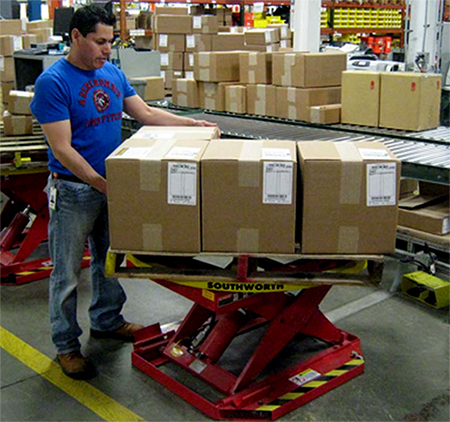
Lift tables sit line-side and can be adjacent or connected. Loads are diverted onto them by ball transfers, spurs or decline conveyor lines for further work or processing. As with in-line tables, this allows greater and more ergonomic access to the conveyed loads. In a distribution application, this may be used to move a load to a parallel line or to allow easier forklift access to a palletized load. In assembly operations, this allows workers to manipulate, rotate, lower and raise loads for work.
End-of line scissor lifts
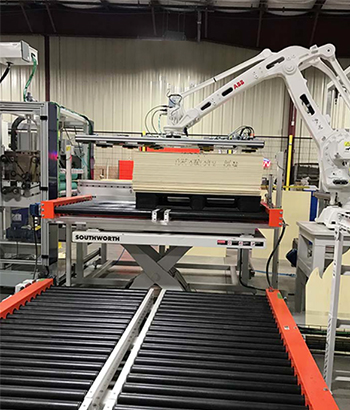
Above: conveyor at the end of line integrated with scissor lift and robots
Conveyors discharge their loads onto a lift at the end of a line. In these applications, the lift is in-line and can lower or raise the load as well as rotate it for further work. One way this can be used is to lower a pallet on a low-profile lift for pallet jack access. In some cases, the lift may be used to dump items from a conveyor line.
Vertical lift conveyor integrations
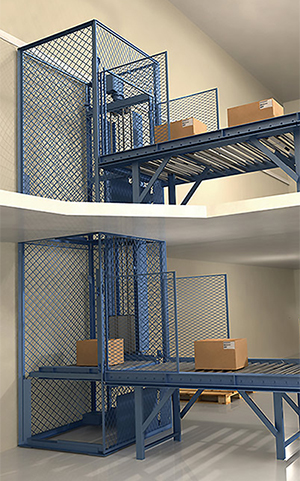
These integrations transport pallets or packages directly onto or off of a vertical reciprocating conveyor for elevation to a mezzanine or another conveyor line. Unlike scissor lifts, which can integrate directly into conveyor lines, VRCs tend to be fed by conveyors and have a different set of criteria for safe and effective load transitions.
Moving Material Vertically – VRC’s, Conveyors, and Other Options
Loading techniques for conveyors & lifts
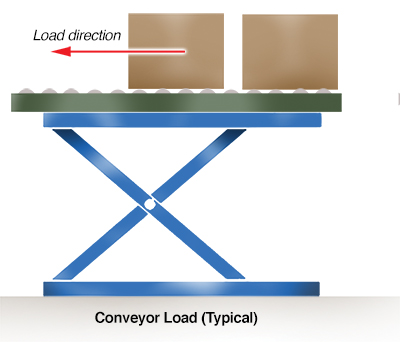
Conveyor loading tends to be one of the easiest ways to “slide load” a scissor lift.
While sliding loads require forethought in lift design, conveyors lessen the impact on the lift compared to a rolling axle load (like a forklift). When loads convey onto lifts (fitted with conveyor rollers), the end roller will not need to bear the load’s full weight due to deflection within the lift’s mechanism. For instance, consider an incremental load like a metal or wood sheet. The edge loading and impact aren’t nearly as severe when conveyed onto the lift than if driven on with a forklift or cart. Here’s what you need to consider when conveying loads onto lift tops.
- Friction and impact: Conveying a sheet, carton, tote or component onto a lift table eliminates most friction on the item being conveyed (that’s the nature of conveyors). Sliding something onto a flat lift has a coefficient of friction of right at 30%, but conveyance adds almost nothing. Certain items, like rubber, can increase the coefficient of friction. Impact on the lift may be a factor for very high-speed applications and should be evaluated when the lift is specified.
- Horizontal impacts and stops: Lift-integration with conveyors often requires stops. With a stop, the horizontal force impact should be parallel to the lift’s legs and should never be perpendicular. If needed, add shock absorbers for particularly heavy or fast loads. Know the weight (or weights) of all conveyed loads when stops are involved.
- Incremental layers: When you’re conveying loads that layer atop each other on the lift and conveyors, each individual load increment should be considered a percentage of the total required lifting capacity. The weight of each layer should be known as well as the maximum total weight the lift will accept. Small percentages are no factor and large percentages may dictate choosing units with higher edge load ratings. If the incremental layers are conveyed onto a lift in the raised position, see below.
- Load increment footprint vs. overall platform size: If the load footprint matches the platform size, the load should roll into the lift gradually and the impact on edge loading is minimal. If the load footprint is smaller than the platform, it may have more of an impact on the lift and should be designed into the system during specification.
- Load increment footprint vs. minimum platform size: The minimum platform size is equal to the support leg outline. If the lift has a minimum platform size, then the load will always convey onto a leg support. When there is an oversized top, the load should have at least half its footprint and weight over the “supporting leg outline” when it isn’t supported by the conveyor line that delivers it to the lift table (or other adjacent surface, if the load is slid off a table or workstation onto a conveyor-top lift).
- Load increment center of gravity relative to minimum platform size: If your load isn’t uniform in dimensions, shape or weight, the conveyor integration must ensure that the load’s center of gravity is always within the supporting leg outline when it moves off the adjacent conveyor line and onto the lift table structure.
Consult with us to ensure a safe, stable and smooth transition that doesn’t overload the lift or stress its support structure. Remember that the load’s stability depends on load placement, weight and direction. When done correctly, these integrations result in highly productive lift/conveyor integrations that reduce labor, increase ergonomics, speed throughput and make the entire process more efficient.
This article is informational in nature. To safely integrate lifts and conveyors, professional engineering services are often required.
More resources
- Download guides: Conveyor and Scissor Lifts (PDFs: opens in new tab)
- A Jargon-Free Guide to Vertical Conveyors
- When to Transport Loads with Overhead Conveyor Systems
Scott Stone is Cisco-Eagle's Vice President of Marketing with 35 years of experience in material handling, warehousing and industrial operations. His work is published in multiple industry journals an websites on a variety of warehousing topics. He writes about automation, warehousing, safety, manufacturing and other areas of concern for industrial operations and those who operate them.



